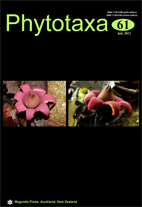Abstract
Tillandsia cucaensis is re-established and lectotypified. It was commonly considered as a synonym of T. makoyana, but it differs from it by its green corolla, pink axis (vs. violet corolla and bright red axis), and its larger flowers and floral bracts. Tillandsia cucaensis has been confused with a phenetically similar taxon, which turned out to be a new species, described here as T. izabalensis. This differs from T. cucaensis by its softer, abaxially smooth leaves, floral bracts that are smooth upon drying, and spreading stigma lobes (vs. stiffer, abaxially veined leaves, floral bracts strongly veined upon drying, and spiraled stigma lobes). In addition, T. cucaensis is restricted to the Pacific slopes from Tropical Mexico into northwestern Costa Rica, while T. izabalensis occurs only in the Gulf of Honduras. Moreover, T. aesii is treated as a synonym of T. cucaensis, since no evidence supports it as a distinct species. Conservation status of both species was assessed as LC (Least Concern) following the criteria of the IUCN.

